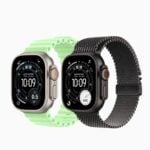Your Apple Watch offers a convenient way to monitor and track your cardio fitness levels using VO2 max measurements. By understanding these measurements and incorporating regular exercise into your routine, you can take proactive steps towards improving your overall health and well-being.
Understanding Cardio Fitness Levels on Your Apple Watch
What is VO2 Max?
VO2 max measures the maximum amount of oxygen your body uses during exercise. It’s a key indicator of cardiovascular health and overall fitness. A higher VO2 max generally signifies better aerobic endurance and overall health.
How Apple Watch Measures VO2 Max
Apple Watch (Series 3 or later) estimates your VO2 max using heart rate and motion data during outdoor walks, runs, or hikes. The watch considers factors like age, sex, height, weight, and medications that might affect heart rate.

Viewing Your Cardio Fitness Levels
You can view your cardio fitness level in the Health app on your iPhone. Navigate to Browse > Heart > Cardio Fitness. The app provides a range for your level (high, above average, below average, low) based on age and sex.
Improving Your Cardio Fitness
Regular exercise, particularly aerobic activities like running, swimming, or cycling, can improve your VO2 max over time. The Health app offers insights and tips on enhancing your cardio fitness.

Important Considerations
- Age: VO2 max naturally declines with age.
- Sex: Men generally have higher VO2 max than women due to physiological differences.
- Medications: Certain medications can affect heart rate and potentially impact VO2 max measurements. Inform your doctor if you’re taking any medications that might influence your heart rate.
- Medical Conditions: Consult your doctor if you have any concerns about your cardiovascular health or experience unusual symptoms during exercise.
Understanding the Levels
| Level | Description |
|---|---|
| High | Indicates excellent cardio fitness, associated with a lower risk of cardiovascular disease. |
| Above average | Suggests good cardio fitness, providing numerous health benefits and a lower risk of chronic diseases. |
| Below average | May indicate a need to improve cardio fitness through regular exercise. |
| Low | Indicates a need for significant improvement in cardio fitness, consult a doctor for personalized guidance. |
Understanding VO2 Max
VO2 Max represents the peak amount of oxygen the body can use during intense exercise, and it’s a key metric for cardiovascular fitness.
The Science of VO2 Max
VO2 Max, or maximal oxygen uptake, is the measurement of the maximum volume of oxygen that an individual can utilize during intense, whole-body exercise. It is usually expressed in milliliters of oxygen consumed per kilogram of body weight per minute (mL/kg/min). The heart plays a crucial role in pumping oxygen-rich blood to muscles, and this number reflects how well the heart and lungs are delivering and the muscles are using oxygen.
Importance for Cardio Fitness Levels
Cardio fitness levels are closely linked to cardiorespiratory fitness, which the VO2 Max measurement can indicate. A higher VO2 Max signifies a greater aerobic capacity, suggesting that a person’s body can transport and utilize oxygen more efficiently during exercise. This is important because better cardio fitness is associated with reduced risk of chronic diseases.
Measuring with Apple Watch
The Apple Watch utilizes its heart and motion sensors to provide an estimate of a user’s VO2 Max. It does this during certain workouts, like an outdoor walk, run, or hike that’s logged in the Workout app. The data recorded by the watch gives users a clear picture of their cardio fitness levels by estimating VO2 Max, which can be especially useful for tracking improvements over time.
Setting Up VO2 Max Measurement on Apple Watch
Beginning with watchOS 7.2, the Apple Watch Series 3 or newer models have the feature to estimate your cardio fitness levels using VO2 max measurements. Here is a simple guide to get you started.
Step 1: Check Compatibility
Ensure your iPhone is running iOS 14.3 or later, as it’s necessary for syncing with your Apple Watch.
Step 2: Update Your Watch
Update your Apple Watch to watchOS 7.2 to enable the feature that measures your cardio fitness level.
Step 3: Open the Health App
On your iPhone, head to the Health app. This is where all your fitness data, including VO2 max information, gets stored and analyzed.
Step 4: Find the Cardio Fitness category
Within the Health app, search for the ‘Heart’ category. Here, you will find ‘Cardio Fitness’ which is your gateway to VO2 max data.
Step 5: Enable Notifications
For a nudge when your cardio fitness is at a low level, toggle on ‘Cardio Fitness Notifications’. These are helpful reminders to stay active.
Step 6: Wear Your Watch Correctly
To get accurate VO2 max estimates, ensure the heart rate monitor on your Apple Watch is in contact with your skin. The watch should be snug but comfortable.
Using these steps, you can harness your Apple Watch’s ability to monitor your cardio fitness through VO2 max. Remember, the data becomes more accurate over time with regular use, so keep active and check your levels through the Fitness or Health apps.
Optimizing VO2 Max Readings
Ensuring that your Apple Watch provides the best possible VO2 max readings involves accurate calibration and an understanding of the factors that influence these metrics.
Calibrating Apple Watch for Accurate Data
For the most precise VO2 max calculations, it’s vital that your Apple Watch be calibrated correctly. Calibration helps the watch learn your individual fitness level and stride patterns. Begin by going to an open area with clear GPS reception and bring your iPhone with you for the first few calibration workouts. The Apple Watch utilizes the GPS from your iPhone to validate its own sensors for more accurate heart rate data and movement tracking. Here’s a simple breakdown:
- Ensure your personal information (age, sex, weight) is current on your Health profile.
- Perform workouts using the Apple Watch’s built-in Workout app, ideally outdoor walks or runs.
- Aim for at least 20 minutes of activity to give your watch enough data to work with.
Understanding Factors Affecting VO2 Max
Several factors can impact your VO2 max score, and being aware of them can help you interpret your readings better. Your age and sex are key determinants; naturally, they affect your body’s oxygen usage. Your fitness level is another driving force – the better shape you’re in, the more likely you are to have a higher VO2 max. Here’s what to consider:
- Age and Sex: These are used in algorithms to compare your fitness levels with average values.
- Weight: Heavier weights generally result in lower VO2 max readings.
- Heart Rate Data: Accurate heart rate monitoring is essential for reliable VO2 max estimations.
- Fitness Level: Improving your overall fitness can lead to a higher VO2 max value.
By keeping these aspects in check, you’re on your way to getting the most accurate and optimized VO2 max readings from your Apple Watch.
Interpreting Your Results
When you strap on an Apple Watch and start sweating it out in your favorite workout, it keeps a close eye on how much oxygen you’re using. This number says a lot about your heart health. So, let’s break down what those numbers mean for you.
VO2 Max and Health App Integration
Your Apple Watch’s VO2 max score is a snapshot of your cardiovascular fitness. It measures the maximum volume of oxygen you can utilize during intense activity. This data doesn’t just stay on your watch; it syncs with the Health app on your iPhone. Here’s how it works:
- Health App: Your VO2 max data is sent here and updated after each applicable workout.
- Heart Rate Data: The Health app also keeps track of your heart rate data, collected by your watch.
- Alerts and Notifications: Receive alerts if there are significant changes in your fitness levels.
Knowing your VO2 max can help you tailor your training and set smarter fitness goals. It’s not just a number; it’s a marker of your overall health and a predictor of cardiovascular health.
Comparing VO2 Max to Normative Data
It’s one thing to have your VO2 max numbers; it’s another to know what to do with them. To make sense of your score, compare it to normative data:
- Age and Gender: These factors influence what’s considered a “good” VO2 max score.
- Fitness Goals: Align your scores with your fitness objectives.
Here is a simple way to understand where you stand:
- Below Average: Might be a sign to step up your fitness routine.
- Average: You’re in line with most people in your age and gender category.
- Above Average: Indicates good cardiovascular health and endurance capacity.
Keep an eye on these scores over time. Improvements show you’re on the right track with your fitness journey, and stagnation could mean it’s time to switch things up. Remember, the goal is to maintain or improve your score for long-term heart health and physical well-being.
Improving Your VO2 Max
VO2 Max is a measure of cardiovascular fitness, and enhancing it can lead to better endurance and overall exercise performance. The Apple Watch provides tools to monitor this key health metric.
Recommended Exercises for Higher VO2 Max
To elevate one’s VO2 Max, they should integrate a variety of exercises that focus on sustained intensity.
- High-Intensity Interval Training (HIIT): This includes short bursts of intense activity followed by recovery periods. For instance:
- Sprinting for 1 minute, then walking for 2 minutes, repeating for at least 20 minutes.
- Cycling at maximum effort for 30 seconds, followed by a slower pace for 1 minute.
- Steady-State Cardio: Such as running or using a treadmill, should be performed at a moderate intensity where one can talk but not sing.
- Aim for at least 150 minutes a week of activities like outdoor walks, jogs, or hiking.
- Cross-Training: Incorporate other forms of aerobic exercises like swimming or rowing to work different muscle groups.
Tracking Progress Over Time
The Apple Watch, acting as a fitness tracker similar to a Fitbit, is a useful tool for keeping a close watch on improvements.
- Daily Monitoring:
- Check the Health app daily to see the VO2 Max score change with workouts.
- Use the ‘Outdoor Walk’ and ‘Outdoor Run’ workouts on the Apple Watch to get more accurate readings by providing GPS data.
- Weekly and Monthly Reviews:
- Look at weekly and monthly trends in the Health app to understand longer-term progress. This data can motivate an individual to maintain or adjust their workout intensity.
- Performance Metrics:
- Use the Apple Watch to track heart rate, calories burned, and exercise duration. These metrics help evaluate workout efficiency.
By applying these strategic exercises and tracking methods, individuals can work toward progressively increasing their VO2 Max, which is a clear sign of improving cardiovascular health.
Apple Watch VO2 Max in Practice
The Apple Watch VO2 Max feature isn’t just a number; it’s become a practical tool for both athletes and health-conscious individuals. By tracking and providing insights into cardiovascular fitness, it helps users make informed decisions about their exercise routines and overall health.
Real-Life Applications for Athletes
For athletes, the VO2 max reading gives a clear snapshot of their current fitness level. When an athlete goes for outdoor runs or hikes, the watch measures the maximum amount of oxygen they can use during intense physical activity. This data is vital because it can help:
- Tailor Training: By tracking changes in VO2 max over time, athletes can adjust their training intensity and volume for peak performance.
- Set Benchmarks: Comparing their scores with norms for their sport allows athletes to set fitness goals.
- Receive Timely Alerts: If an athlete’s VO2 max dips unexpectedly, it could signal a need for rest or a change in training.
Athletes can use this feedback to prevent overtraining and to make sure they’re in top shape for competitions.
Using Data for Long-Term Health Monitoring
Daily activities like hikes and even brisk walks contribute to long-term heart health and can be monitored using the Apple Watch. Here are the benefits for long-term health monitoring:
- Identify Trends: By consistently measuring VO2 max, users can detect long-term trends in their cardiovascular fitness.
- Detect Health Risks: A continually low VO2 max could be an early sign of potential health issues, such as type 2 diabetes or heart disease.
- Motivate Regular Exercise: Notifications can encourage users to stay active, improving both cardio fitness and overall well-being.
This feature turns the abstract concept of fitness into concrete, actionable data, fostering a proactive approach to maintaining and improving long-term health.
Frequently Asked Questions
The Apple Watch provides an estimate of VO2 max, offering insight into your cardio fitness during certain workouts. This feature taps into the onboard sensors to deliver these estimates.
How accurate is the Apple Watch’s VO2 max measurement during workouts?
The Apple Watch’s estimation of VO2 max is generally reliable for outdoor walks, runs, and hikes, although factors like fit and workout intensity can influence accuracy. For best results, users should ensure the watch is snug on their wrist and maintain consistent high-intensity workouts.
What could prevent my Apple Watch from recording my VO2 max?
Several factors can interfere with your Apple Watch’s ability to record VO2 max, such as the watch’s fit on your wrist, the presence of tattoos that cover the skin sensors, and not using the Workout app for recorded exercises.
Is there a way to track VO2 max for cycling with the Apple Watch?
Currently, the Apple Watch doesn’t provide VO2 max estimations for cycling. The feature is limited to certain types of workouts such as running and walking where the motion and heart rate sensors can more accurately measure effort.
Can VO2 max be measured on indoor runs with an Apple Watch?
The Apple Watch is not designed to estimate VO2 max for indoor runs as accurately as it does for outdoor activities. The calibration is optimized for open-air environments where GPS data can assist in determining workout intensity.
How does altitude affect the Apple Watch’s VO2 max readings?
Altitude can impact the oxygen availability and might affect the heart rate, which in turn could influence the VO2 max readings on your Apple Watch. It can sometimes lead to measurements that differ from lower elevations.
How does age impact what is considered a good VO2 max score?
Age is a factor in determining what is considered a good VO2 max score. Younger individuals typically have higher scores than older adults due to the natural decline in cardiorespiratory fitness as one ages. The Apple Watch takes age into account when providing fitness assessments.







